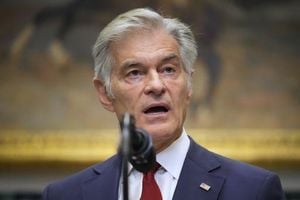Thousands of travelers, both from across the United States and around the world, have found themselves staring at locked gates and closed visitor centers as the government shutdown entered its first full week in October 2025, sending ripples through America’s beloved national parks and federal tourist sites. For many, the dream of standing beneath the ancient redwoods at Muir Woods National Monument or gazing out over the Grand Canyon has been dashed, at least for now.
On October 4, 2025, visitors arriving at Muir Woods National Monument, just north of San Francisco, were met by park rangers turning them away. As reported by NPR, the closure came as a result of the ongoing government shutdown, which has upended travel plans for thousands. Bob Talipan, a visitor from Baltimore, summed up the frustration many felt: "We saw the sign on the side of the road coming up after the Golden Gate Bridge – Muir Woods closed. Said, oh, yeah, government shutdown." The disappointment was palpable, especially for international tourists like Abel Philip, who had traveled all the way from Mumbai, India, only to be stopped at the entrance. "So that is something, you know, very inconvenient, especially for tourists coming all the way from India. So yeah, that's pretty sad, I would say," Philip told NPR.
These scenes have played out across the country, with travelers who booked reservations or purchased passes months in advance now forced to change plans or seek alternative routes into public lands. According to The New York Times, about two-thirds of the National Park Service’s workforce have been furloughed, leaving parks with only a skeleton crew to handle essential functions such as law enforcement and emergency services. The result? Many parks are technically open, but facilities like visitor centers, bathrooms, and guided tours are shut down, and the remaining staff are stretched thin.
California, home to more national parks than any other state, has been particularly hard hit. While the state’s nine national parks remain broadly open to visitors, services are severely limited. Muir Woods, famed for its towering coastal redwoods—some over a thousand years old—has been closed entirely. Yosemite National Park, about four hours away, remains open but is operating with only critical staff. Meanwhile, at Joshua Tree National Park, the Black Rock Nature Center is closed, and there are fears of a repeat of the last shutdown in 2019, when trash piled up, bathrooms overflowed, and vandalism became rampant.
Don Neubacher, former superintendent at Yosemite and Point Reyes National Parks, explained the dilemma to NPR: "So parks are left open. Then it's calamity – right? – 'cause you just don't have the staff to take care of the parks overall." The absence of staff doesn’t just mean inconvenience for visitors; it can have lasting effects on the parks themselves. Russell Galipeau, who served as superintendent of Channel Islands National Park for 15 years, warned that scientific research and conservation programs have been suspended. "All those programs get shut down, and so we no longer have that canary in the coal mine that's giving us an indicator of what's the health of not just the park, not just the ecosystem, but the place we live," Galipeau said, highlighting the broader consequences of the shutdown.
The impact is not limited to California. Across the country, the shutdown has created a patchwork of closures, limited services, and confusion. In Utah, the state’s five national parks—Zion, Arches, Canyonlands, Capitol Reef, and Bryce Canyon—have remained open, with visitor centers either open or slated to reopen soon, according to the Utah Office of Tourism. Colorado’s eight National Park Service sites, including Rocky Mountain and Mesa Verde, are staying open for now using fee revenues, but that funding is finite. Local law enforcement and even county sheriffs have stepped in to support park operations where possible.
Some sites have not been so lucky. In New Mexico, Carlsbad Caverns National Park has closed all roads and caves for the duration of the shutdown. White Sands National Park is also closed until further notice. The story is similar in other states. The Grand Canyon National Park in Arizona remains open, but entrance fees are no longer being collected, and all buildings operated by the National Park Service—including visitor centers—are closed, according to the Grand Canyon Conservancy. Petrified Forest National Park, which typically closes overnight, is likely inaccessible as well.
There are, however, some bright spots. Great Smoky Mountains National Park, the country’s most visited national park, has stayed open, thanks to a joint plan involving several state and local agencies and the Eastern Band of Cherokee Indians. Staff members are on duty to clean restrooms and protect both visitors and wildlife. In Maine, Acadia National Park is "mostly open," with essential visitor services intact, and the road to Cadillac Mountain, offering sweeping views of the coastline, has reopened after a brief closure.
Urban attractions have not been spared. In Washington, D.C., many museums and monuments remain open, but several have closed, including the Library of Congress, the National Archives Museum, the Washington Monument, and the National Arboretum. Tours of the Capitol Building and the Pentagon have been suspended. The Smithsonian Institution, which runs many of the capital’s most famous museums and the National Zoo, has pledged to remain open through October 11, 2025, but the future is uncertain if the shutdown drags on.
Other iconic sites have also felt the sting. In Philadelphia, the Liberty Bell Center, Independence Hall, and the Benjamin Franklin Museum are closed. In St. Louis, the tram to the top of the Gateway Arch has been suspended, and all ticketed events have been canceled until further notice.
The disruption extends beyond inconvenience. As NPR and The New York Times both note, the shutdown is not just about locked gates and disappointed tourists. The suspension of scientific research and conservation programs means that vital ecosystem monitoring and preservation efforts are on hold. During the 2019 shutdown, the longest in U.S. history, neglect and vandalism left scars on some of the nation’s most treasured landscapes.
Meanwhile, visitors from around the globe, like Amelia Lei Cabatit from Hong Kong, find themselves navigating a maze of closures and uncertainty. Cabatit, who had planned to visit Yosemite after being turned away from Muir Woods, reflected the confusion many feel: "I booked a tour to Yosemite." When told she’d need to check if it was open, she replied, "Oh, no. OK." For now, travelers are left to hope that their next stop will be accessible, and that the parks they came so far to see will weather this latest storm.
As the shutdown continues, America’s national parks and the people who love them are caught in limbo, waiting for a resolution that will restore access—and protection—to these irreplaceable treasures.




